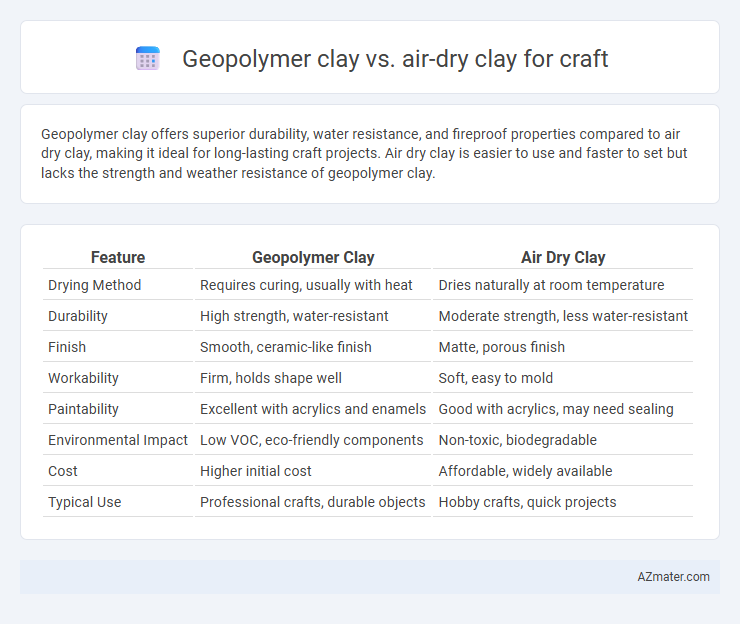Geopolymer clay offers superior durability, water resistance, and fireproof properties compared to air dry clay, making it ideal for long-lasting craft projects. Air dry clay is easier to use and faster to set but lacks the strength and weather resistance of geopolymer clay.
Table of Comparison
| Feature | Geopolymer Clay | Air Dry Clay |
|---|---|---|
| Drying Method | Requires curing, usually with heat | Dries naturally at room temperature |
| Durability | High strength, water-resistant | Moderate strength, less water-resistant |
| Finish | Smooth, ceramic-like finish | Matte, porous finish |
| Workability | Firm, holds shape well | Soft, easy to mold |
| Paintability | Excellent with acrylics and enamels | Good with acrylics, may need sealing |
| Environmental Impact | Low VOC, eco-friendly components | Non-toxic, biodegradable |
| Cost | Higher initial cost | Affordable, widely available |
| Typical Use | Professional crafts, durable objects | Hobby crafts, quick projects |
Introduction to Geopolymer Clay and Air Dry Clay
Geopolymer clay is an advanced, eco-friendly material composed primarily of aluminosilicate minerals that cure through a chemical reaction, resulting in durable, heat-resistant crafts ideal for detailed and long-lasting projects. Air dry clay is a water-based clay that hardens naturally at room temperature without requiring kiln firing, offering convenience for quick, non-toxic, and accessible craft applications. Both clays differ significantly in strength, drying time, and application versatility, making them suitable for distinct crafting needs.
Composition and Material Differences
Geopolymer clay consists primarily of aluminosilicate materials activated by alkaline solutions, resulting in a strong, durable, and heat-resistant material ideal for detailed and structural crafts. Air dry clay is typically composed of natural clay, water, and additives like cellulose or starch, designed to harden by moisture evaporation without firing. The inorganic, synthetic origin of geopolymer clay contrasts with the organic, water-based composition of air dry clay, affecting their workability, drying time, and final strength.
Environmental Impact and Sustainability
Geopolymer clay demonstrates superior environmental benefits compared to air dry clay due to its low carbon footprint and the use of industrial by-products like fly ash. Air dry clay often contains synthetic additives and requires energy-intensive processing, contributing to higher environmental impact. Choosing geopolymer clay supports sustainability by reducing waste and minimizing resource consumption in craft projects.
Ease of Use for Craft Projects
Geopolymer clay offers a smooth, consistent texture that is easy to shape and holds fine details well, making it ideal for intricate craft projects. Air dry clay is user-friendly and requires no baking or special equipment, allowing quick and straightforward drying at room temperature. Both clays cater to varying skill levels, but air dry clay is generally more accessible for beginners due to its simple preparation and cleanup process.
Drying Time and Curing Process
Geopolymer clay typically requires a controlled curing process involving heat or specific humidity conditions to harden properly, resulting in a durable, water-resistant finish. Air dry clay dries naturally at room temperature within 24 to 72 hours but may remain more porous and less strong compared to geopolymer clay. The drying time of air dry clay is faster and more convenient for quick projects, while geopolymer clay's curing process enhances structural integrity for long-lasting crafts.
Durability and Longevity of Finished Crafts
Geopolymer clay offers superior durability and longevity compared to air dry clay, as it hardens into a strong, water-resistant material suitable for outdoor and high-stress applications. Air dry clay tends to be more porous and fragile, making it susceptible to cracking, chipping, and moisture damage over time. Crafts made with geopolymer clay maintain structural integrity longer, ensuring lasting aesthetic and functional value.
Finish, Texture, and Painting Options
Geopolymer clay offers a smooth, durable finish that is ideal for detailed sculpting and provides a non-porous, stone-like texture, making it excellent for intricate craft projects. Air dry clay typically has a softer, matte finish with a slightly porous texture, which can lead to a more rustic and natural look but may require sealing before painting. Painting options for geopolymer clay include acrylics and enamels that adhere well to its dense surface, while air dry clay requires primer or sealant to prevent paint absorption and offers versatility for watercolors, acrylics, and inks.
Cost Comparison: Geopolymer vs Air Dry Clay
Geopolymer clay typically costs more upfront than air dry clay due to its specialized chemical components and enhanced durability. Air dry clay remains a budget-friendly option favored by hobbyists and educators for its low price and easy availability in bulk. Evaluating the lifecycle cost, geopolymer clay can offer long-term savings by reducing the need for repair or replacement in durable craft projects.
Best Applications for Each Clay
Geopolymer clay excels in creating durable, weather-resistant sculptures and functional art pieces due to its high strength and ability to withstand outdoor conditions. Air dry clay is ideal for lightweight, detailed craft projects such as jewelry, small figurines, and school art activities, requiring no kiln and offering easy paintability. For long-lasting, structural items, geopolymer clay is preferred, while air dry clay suits quick, indoor crafts and beginner-friendly applications.
Choosing the Right Clay for Your Craft Needs
Geopolymer clay offers superior durability and resistance to moisture compared to air dry clay, making it ideal for long-lasting, detailed craft projects that require strength. Air dry clay is more user-friendly for beginners, as it requires no baking or curing and is easier to shape and paint once dry. Selecting the right clay depends on your project's durability needs and skill level, with geopolymer clay suited for professional or outdoor crafts and air dry clay perfect for quick, indoor creations.

Infographic: Geopolymer clay vs Air dry clay for Craft
 azmater.com
azmater.com